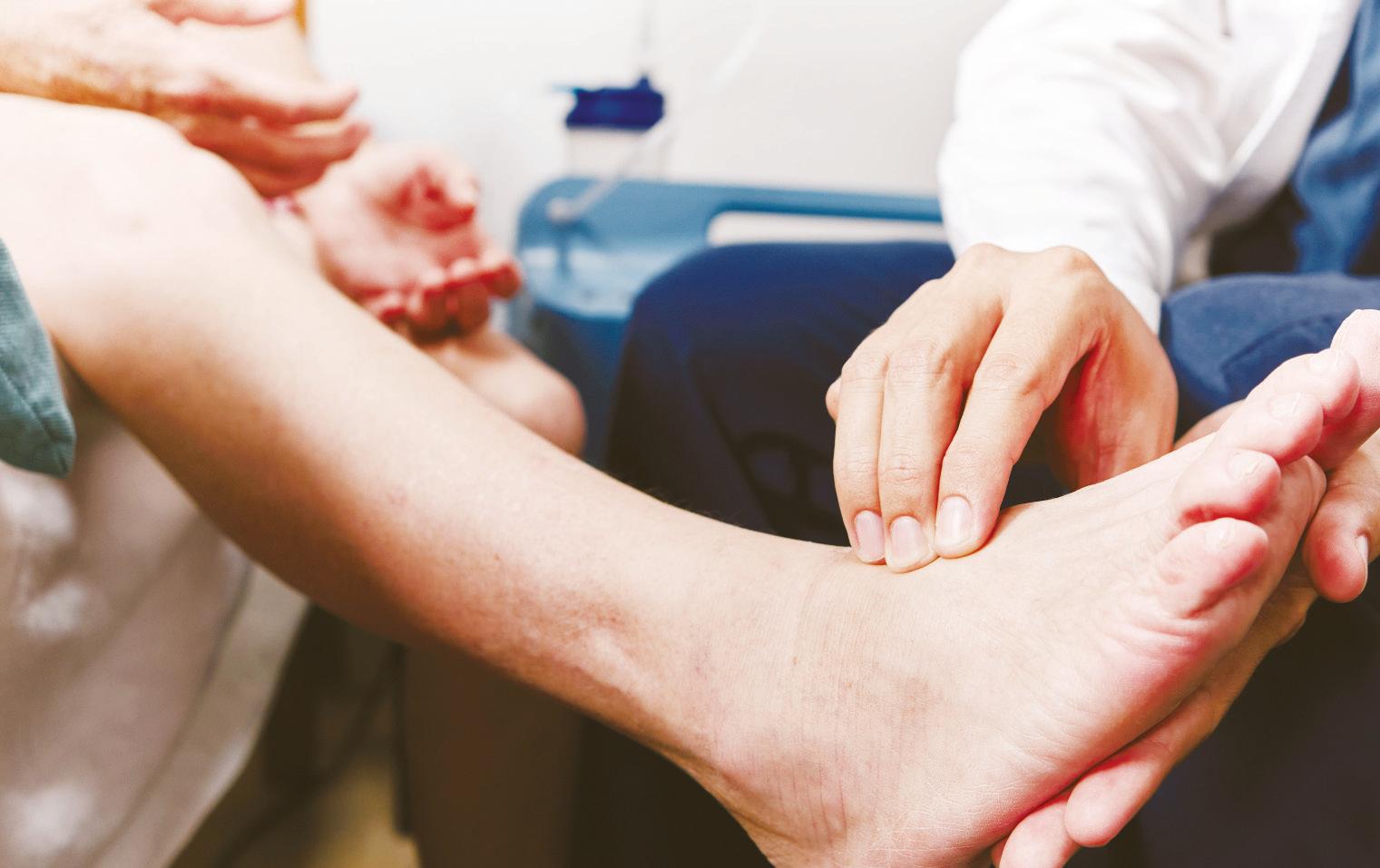
5 minute read
Living With Diabetes?
3 Austin South Asian | December 2022 Living With Diabetes? Why You Need To Pay Attention To Your Feet
Diabetes can impact the body in a number of ways, especially creating potentially serious complications for your feet.
“Foot care is a central component of overWhile still relatively rare, Charcot foot seems to be growing in prevalence as more Americans develop diabetes. This sudden destruction and erosion of the foot’s bones, caused by severe nerve damage, can trigger
all diabetes care,” says Bryce Paschold, DPM, FACFAS, a board-certified foot and ankle surgeon and a fellow member of the American College of Foot and Ankle Surgeons. “Without precautions, even small foot problems can lead to amputation or be life-threatening.”
To help those living with diabetes understand potential complications and how to avoid them, ACFAS is sharing these important insights:
Potential Complications
Nerve damage that affects arms, hands, legs and feet known as diabetic peripheral neuropathy not only makes you more likely to experience numbness, burning, and loss of your protective sensation, but losing sensation in your feet can also make it easier to miss common minor skin pathologies and other foot issues while they’re still relatively easy to treat.
With diabetes, the blood vessels below the knee often become narrow and restrict blood flow, causing infections that don’t heal. This common and serious complication can lead to the loss of your foot, leg or your life.
Stress fractures and sprains are commonplace among all athletes, but those living with diabetes who experience neuropathy are more likely to be unaware of foot and ankle injuries and exacerbate them by continuing their activities. an avalanche of problems, including joint loss, fractures, collapse of the arch, massive deformity, ulcers, amputation and even death. Symptoms appear suddenly and include warm and red skin, and swelling, but commonly without pain.
Prevention
You can play a vital role in reducing your risk for complications. Here’s how:
• Inspect feet daily. Check for cuts, blisters, redness, swelling and nail problems. Use a magnifying mirror to look at the bottom of your feet. If you need assistance, have someone else do it for you. Be proactive by knowing what is going on with your feet on a daily basis.
• Don’t ignore pain. Seek care immediately if you experience pain in your leg at night or with little activity. It could mean you have a blocked artery.
• Don’t perform “bathroom surgery.” Never trim calluses or corns yourself, and don’t use over-the-counter medicated pads. See a foot and ankle surgeon for proper treatment.
• Keep floors clear. To prevent injury, make sure no needles, insulin syringes or other sharp objects are on the floor. You should also always wear shoes, indoors and outdoors. and ensure your socks aren’t bunched up. Wear lighter colored socks so you’ll notice blood or drainage if they occur.
• Be temperature aware. Never use heating pads, hot water bottles, ice or electric blankets, and never put your feet in hot water without testing the temperature; you can easily burn your feet without noticing.
• Stay active. Improve circulation by wiggling your toes and moving your ankles for five minutes, two to three times a day.
• Control blood sugar levels. Good diabetes management reduces your risk of developing complications. • Book an appointment. Visit a foot and ankle surgeon to determine if you have lost any feeling or circulation. Periodic foot exams can also help prevent complications.
“Advanced therapies for foot wounds, such as the use of bioengineered skin substitutes and negative pressure wound therapy, are saving limbs and restoring mobility for people who suffer from nonhealing foot ulcers,” says Dr. Paschold.
For more information and to find a foot and ankle surgeon near you, visit FootHealthFacts.org, the patient education website for the American College of Foot and Ankle Surgeons. (StatePoint)
Why I Chose An Assisted Living Facility In India For My Mother
(Continued From Page 01)
dearly familiar face, taking inventory of the changes: the big bruise near her eye, her weight loss, mosquito bites on her neck, her freshly combed hair, and the sweet smell of
talcum powder.
With moisture gathering in my eyes, I took in the spidery veins tracing unforgettable patterns on the paper-thin skin of her forearms, her milk-white hair, the hooked nose, and those same murky eyes that I hadn’t looked into for four months and 14 days; our longest separation in 16 years. “I am your daughter,” I said. She stared into my face, then turned to look at her caregiver, Vinitha, before turning back.
Suddenly, she smiled, and her face lit up. “When did you come?” she asked softly.
Vinitha fussed around her, adjusting the blanket, her chair, the neckline of her nightgown, and the footstool. I told my mother that I had arrived that morning from California.

My 89-year-old mother had lived in our home in California since 2006. However, it had taken a complicated series of events and considerations that resulted in her occupying Room 211 at Athulya Assisted Living in Chennai, India.
The air-conditioner blasted on high, abating the heat and moistness of August in Chennai. My mother sat on the easy chair I’d bought in March. A blue blanket that my brother gifted was tucked around her. It was the same one that had been folded at the foot of her bed in our house for years.
Nee yaaru? (Who are you?) my mother asked in Tamil, and her question gouged at me.
“California?” she asked, and her voice was higher-pitched. “Have you come to take me back?”
I paused. That option was no longer a possibility. “Yes, Amma, if you want to come back,” I responded.
Descent into Dependency
In the early years, my mother participated in my life in big and small ways, helping raise my children, cooking and managing the kitchen, worrying over sniffles and coughs, and showing up for my daughters’ ball games and dance performances. (Continued On Page 08)










